英语合同的特点和翻译
合同英语翻译方法

合同英语翻译方法翻译商务英语合同的时候,有什么技巧可以避免我们犯一些常见的错误?下面是我给大家整理的,供大家参阅!商务商务合同属于法律性公文,所以英译时,有些词语要用公文语词语、特别是酌情使用英语惯用的一套公文语副词,就会起到使译文结构严谨、逻辑严密、言简意赅的作用。
一.公文副詞但是从一些合同的英文译本中发现,这种公文语副同常被普通词语所代替,从而影响到译文的质量。
实际上,这种公文语惯用副同为数并不多,而已构词简单易记。
常用的这类副词是由 here、there、where 等副词分别加上 after、by、in、of、on、to、under、upon、with 等副词,构成一体化形式的公文语副词。
例如:从此以后、今后:hereafter;此后、以后:thereafter;在其上:thereon hereupon;在其下:thereunder;对于这个:hereto;对于那个:whereto;在上文:hereinabovehereinbefore;在下文:hereinafterhereinbelow;在上文中、在上一部分中:thereinbefore;在下文中、在下一部分中:thereinafter.现用两个实例,说明在英译合同中如何酌情使用上述副词。
例 1:本合同自买方和建造方签署之日生效。
This Contract shall come into force from the date of execution hereof by the Buyer and the Builder. 例 2:下述签署人同意在中国制造新产品,其品牌以此为合适。
The undersigned hereby agrees that the new products whereto this trade name is more appropriate are made in China.二、谨慎选用极易混淆的词语英译商务合同时,常常由于选同不当而寻致词不达意或者意思模棱两可,有时甚至表达的是完全不同的含义。
试论功能对等理论视角下的商务英语合同翻译
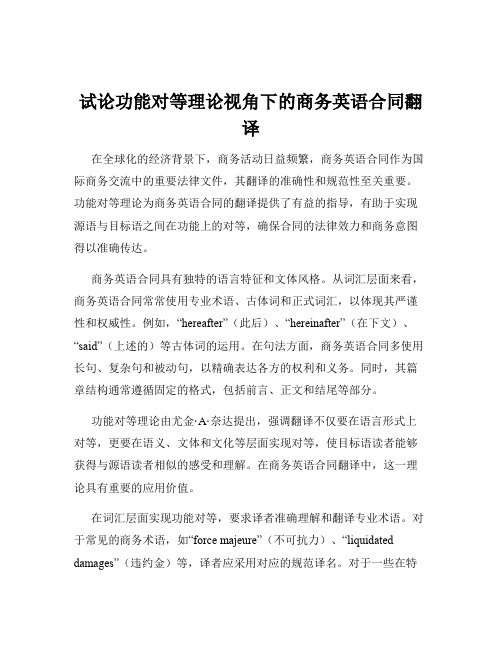
试论功能对等理论视角下的商务英语合同翻译在全球化的经济背景下,商务活动日益频繁,商务英语合同作为国际商务交流中的重要法律文件,其翻译的准确性和规范性至关重要。
功能对等理论为商务英语合同的翻译提供了有益的指导,有助于实现源语与目标语之间在功能上的对等,确保合同的法律效力和商务意图得以准确传达。
商务英语合同具有独特的语言特征和文体风格。
从词汇层面来看,商务英语合同常常使用专业术语、古体词和正式词汇,以体现其严谨性和权威性。
例如,“hereafter”(此后)、“hereinafter”(在下文)、“said”(上述的)等古体词的运用。
在句法方面,商务英语合同多使用长句、复杂句和被动句,以精确表达各方的权利和义务。
同时,其篇章结构通常遵循固定的格式,包括前言、正文和结尾等部分。
功能对等理论由尤金·A·奈达提出,强调翻译不仅要在语言形式上对等,更要在语义、文体和文化等层面实现对等,使目标语读者能够获得与源语读者相似的感受和理解。
在商务英语合同翻译中,这一理论具有重要的应用价值。
在词汇层面实现功能对等,要求译者准确理解和翻译专业术语。
对于常见的商务术语,如“force majeure”(不可抗力)、“liquidated damages”(违约金)等,译者应采用对应的规范译名。
对于一些在特定合同中出现的生僻或新的术语,译者需要通过上下文和专业知识进行推断和翻译,必要时可以加注解释,以确保目标语读者能够理解其含义。
句法层面的功能对等需要译者灵活处理长句和复杂句。
对于长而复杂的句子,译者可以先分析句子结构,将其分解为若干短句,再按照目标语的表达习惯进行重组。
例如,“The Seller shall be liable for any damage to the goods resulting from improper packaging, provided that the Buyer has given timely notice of such damage to the Seller” 可以翻译为“如果买方已及时将货物因包装不当而受损的情况通知卖方,卖方应对货物的任何此类损坏负责。
英语商务合同的文体特征与翻译

英语商务合同的文体特征与翻译Business Contract Writing and Translation in English: Style and FeaturesAs a lawyer, it is important to draft a business contract in English that outlines the terms and conditions of a deal between two parties. The contract should contain details about the basic information of both parties, their identities, rights, obligations, performance methods, tenure, breach responsibility, and compliance with relevant laws and regulations of China. It should also clearly articulate the rights and obligations of each party, as well as the legal effectiveness and enforceability of the contract. Below are the key features that should be included in an English business contract:1. Basic Information: The contract should contain the full names, addresses, and contact details of both parties. It should also specify the nature of their business relationship, such as the goods or services being sold, and the payment terms.2. Identification of the Parties: It is important to clearly identify the parties in the contract and provide details about their legal status and authority to enter into the contract.3. Rights and Obligations: The contract should spell out the rights and obligations of each party, including their expectationsabout the performance and delivery of goods or services, as well as any warranties, guarantees, or representations.4. Performance Methods: The contract should outline the procedures that the parties must follow to fulfill their obligations, including timelines for delivery and payment requirements. It should also address issues such as product quality, inspection, and acceptance.5. Term and Renewal: The contract should specify the duration of the agreement, including provisions for renewal or extension. It should also outline the conditions for termination, breach, and default.6. Compliance with relevant laws: The contract should encompass all applicable laws and regulations, including those of China, that govern the parties' business relationship. This includes any licensing requirements, permits, or certifications.7. Dispute Resolution: The contract should specify the procedures for resolving any disputes that may arise between the parties, including mediation, arbitration, or litigation.8. Governing Law: The contract should identify the law that will govern the agreement, which may vary depending on the jurisdiction where the contract is negotiated.9. Legal Effectiveness: The contract should clearly state that it is legally binding and enforceable, and that it represents the entire agreement between the parties.In conclusion, it is essential to ensure that the English business contract is in accordance with the legal requirements of China, and that the provisions are clear, precise, and aligned with the expectations of both parties. This will help to minimize the risks of misunderstandings, disputes, and legal challenges that could cause delays or financial losses for the parties involved.。
国际贸易合同的语言特征及翻译

国际贸易合同的语言特征及翻译摘要随着我国经济的快速发展,我国国际贸易活动日益频繁,涉外企业的经营规模也在逐步扩大,而商务合同作为一个重要的法律文件依据,其在国际经济贸易中的作用就不言而喻了。
商务合同作为一种特殊的应用文体,他要求合同语言要有高度的正确性和严谨性,稍有差错和漏洞就有可能带来难以承受的损失。
由于经济发展需求的增加,商务合同的形式也越来越多,涉及面也越来越广,从而翻译的难度也不断加大。
所以我们在把合同英译时,一定要忠实原文,严格把握翻译质量,做到结构严谨、内容准确、言简意赅。
本文主要分析商务英语合同语言的特征,并针对其特征找出翻译的原则,并简要介绍主要的翻译方法以及翻译过程中应该注意的问题。
关键词:国际经贸英语合同,语言特点,翻译原则,翻译方法一.经贸合同语言的特点国际经贸合同按照其重要性与繁简程度不同,可分为正式合同、协议、确认书等书面形式,也可以采用口头或其他形式。
在这里我们主要分析书面合同的语言特点。
其特点主要包括以下几个方面:(一)多用正式用语。
国际贸易合同作为法律文件依据,其语言必须体现其法律文体的严肃性和准确性。
所以在合同语言中,我们必须多用正式用语和法律用语,少用口语词和大众难以理解的词汇。
例如Party A shall repatriate the patient toChina and bear the cost of his passage to Beijing .在合同译文中,我们多用“repatriate”替换“send back”。
又如In case one party desires to sell or assign all orpart of his investment subscribed ,the other party shall have the preemptive right .在这个例句中,“shall”“assign”“preemptive”等词的使用就体现了合同用语的法律性和严谨性。
商务英语翻译 第六章 商务合同翻译

因为贵方订单数量很大,我们目前不能满足需求,但 是我们将尽最大努力为贵方获取货源,一旦情况好转, 一定告知。
请将船期延展至11月30日,有效期延展到12月10日,并尽快 给我方答复。
合同中还会出现一些少见的词汇
e.g. The total Contract price to be paid by Party A pursuant to the Content and Scope of the Contract as stipulated in Section 2 of the Contract is _____. 按本合同第二章规定的合同内容和范围,甲方向 乙方支付的合同总价为___。
presided by sb.
商务合同及协议的词汇特征
3 选词正式 e.g. Any event or circumstance beyond the control of the Parties shall be deemed an event of Force Majeure and shall include, but not be restricted to, fire, storm, flood, earthquake, explosion, war, rebellion, insurrection, epidemic and quarantine restriction.
商务合同及协议的词汇特征
3 选词正式
因为 财务年度末 在……之前 关于 开始 停止做 事实上 认为 愿意做
by virtue of at the close of the fiscal year prior to as regards/concerning/relating to commencement cease to do in effect deem intend/desire to do
合同类文本汉英翻译的特点、原则及策略

总之,汉英合同翻译需要遵循一定的特点、原则和策略,以确保翻译的准确 性和专业性。在实际翻译过程中,译者需要结合具体情况灵活运用各种策略,以 确保合同的顺利履行和双方合法权益的保障。
感谢观看
四、实例分析
下面是一份中文合同及其英文翻译,通过对比分析,可以进一步探讨合同类 文本汉英翻译的特点、原则及策略:
中文合同:甲方与乙方经友好协商,就甲方向乙方销售一批电子产品达成以 下协议:……(具体条款略)
英文翻译: The first party and the second party have agreed upon the following terms through friendly negotiation:...(specific terms omitted)
3、文化差异处理
在合同类文本汉英翻译中,文化差异也是需要译者的一个重要方面。对于一 些具有特定文化背景的词汇或表达方式,译者在翻译时需要进行深入了解和研究, 以确定最准确的翻译方式。例如,“口头协议”在中文中具有较高的法律效应, 但在英文中则更倾向于书面协议。译者在翻译时需要考虑这种文化差异,以避免 产生误解或歧义。
2、结构严谨汉英合同文本结构差异较大,英语合同文本更注重逻辑和结构, 通常采用固定的短语和句式。例如,中文合同中常见的“鉴于……”在英语合同 中应译为“WHEREAS……”或“WHEREBY”。
3、用语规范合同文本用词庄重、规范,常常使用正式用语和法律术语。例 如,“股权转让”应译为“assignment of equity interests”,而不是简单 的“transfer of shares”。
一、合同类文本汉英翻译的特点
1、词汇特点
合同类文本涉及大量专业术语和法律词汇,如“合同法”、“不可抗力”等。 译者需要具备扎实的法律和英语基础知识,以便准确传达合同中的信息。此外, 合同中会经常出现一词多义的现象,如“终止”一词在普通语境下通常表示结束, 但在合同中可能需要表达为“解除”或“撤销”。因此,译者需要对词语的语义 和语境进行精准把握。
实用文体翻译合同的翻译Pragmatic Translation
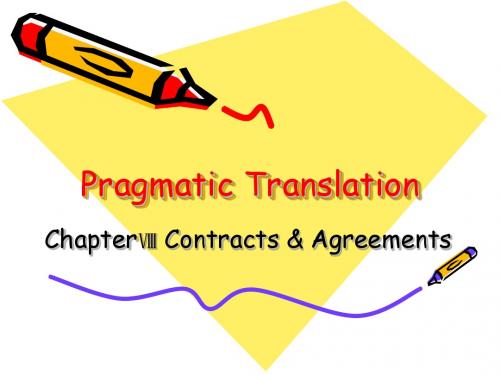
• It has been agreed that Party B may use the trademarks owned by Party A for the sale of the Washing Machines covered herein within the validity. • An agreement has been made that Party B may use the trademarks owned by Party A for the sale of the Washing Machines covered herein within the validity.
Agreement
• THIS AGREEMENT is made the 7th day of October(month), 2009 ( ) (year) between A (hereinafter called "The Company") of the part and B (hereinafter called "The Manager") of the other part. • 第一部分:称为 第一部分:称为parties, 主要介绍合同 , 各方的姓名或名称,及各自在合同的简称。 各方的姓名或名称,及各自在合同的简称。 开头框架一般为: 开头框架一般为: • 句子开头 句子开头THIS AGREEMENT或 或 CONTRACT和当事人的姓名和名称,都 和当事人的姓名和名称, 和当事人的姓名和名称 应大写。 应大写。
• The both parties fulfilling the contract satisfactorily will be the basis for the development of business and further cooperation. • The satisfactory fulfillment of the contract by both parties will be the basis for the development of business and fur2ther cooperation.
商务英语合同的词汇特点包括

商务英语合同的词汇特点包括
1.正式和专业性:商务英语合同使用正式的语言,遵循一定的格式和
结构,以确保合同的法律效力。
合同中使用的词汇通常是专业性的,涉及
到商务和法律领域的术语,需要准确明确地表达合同各方的权利和义务。
2.精准和具体性:商务英语合同中使用的词汇需要具备精准和具体性,以确保合同条款的明确理解和执行。
各项合同条款和条件通常需要被明确
定义和解释,以避免合同争议和误解。
3. 法律性和约束力:商务英语合同涉及到法律领域,因此合同中的
词汇需要具备法律性和约束力。
合同中常用的词汇包括"shall"、"will"、"agreement"、"contract"等,以强调各方在合同下的权利和义务。
4.清晰和简洁:商务英语合同中的词汇应该具备清晰和简洁的特点,
以确保合同各项条款的理解和执行。
合同中的词汇应该避免模糊和歧义,
以避免合同纠纷的产生。
5.可操作性和执行性:商务英语合同中的词汇需要具备可操作性和执
行性,以确保合同的履行和实施。
合同中的词汇应该具备可行性和可解决性,以应对各种可能的情况和问题。
总之,商务英语合同中的词汇需要具备正式、专业、精准、具体、法
律性、约束力、清晰、简洁、可操作性和执行性等特点,以确保合同具备
法律效力和实际可行性。
商务英语中合同的翻译技巧

商务英语中合同的翻译技巧商务英语中合同的翻译技巧一、双方的基本信息1.合同名称:XXX合同2.甲方(英文:Party A):(公司名字/个人名字)(地址:XXX)3.乙方(英文:Party B):(公司名字/个人名字)(地址:XXX)4.签订日期(英文:Date of Execution):(月/日/年)二、各方身份、权利、义务、履行方式、期限、违约责任1.甲方的身份、权利、义务、履行方式、期限、违约责任(1)身份:甲方为出售方;(2)权利:甲方需要出售货物/提供服务;(3)义务:甲方需要按照合同约定的规定,按时、按量、按质地提供货物或服务;(4)履行方式:甲方需要按照约定的交货日期、交货地点、交货方式等送达货物或提供服务;(5)期限:甲方需要按照约定的期限履行义务;(6)违约责任:如甲方未能按照合同约定履行义务,甲方需要承担违约责任,包括但不限于赔偿乙方因此造成的一切损失。
2.乙方的身份、权利、义务、履行方式、期限、违约责任(1)身份:乙方为购买方;(2)权利:乙方需要获得所购货物或服务;(3)义务:乙方需要按时、按量、按质地支付货款;(4)履行方式:乙方需要按照合同约定的收货日期、收货地点、收货方式等接收货物或服务;(5)期限:乙方需要按照约定的期限履行义务;(6)违约责任:如乙方未能按照合同约定履行义务,乙方需要承担违约责任,包括但不限于赔偿甲方因此造成的一切损失。
三、需遵守中国的相关法律法规1.本合同受中国法律的管辖;2.合同受中国法律法规的制约,合同的解释和执行均应符合中国法律;3.若合同的任何规定与中国法律法规相抵触,则以后者为准。
四、明确各方的权力和义务1.甲方的权利(1)甲方有权要求乙方按照合同约定支付货款;(2)甲方有权要求乙方按照合同约定接收货物或服务;(3)甲方有权要求乙方按照合同约定承担违约责任。
2.甲方的义务(1)甲方需要按照合同约定提供货物或服务;(2)甲方需要按照合同约定履行义务;(3)甲方需要按照合同约定承担违约责任;(4)甲方需要保证所提供的货物或服务符合合同约定的质量标准。
商务英语合同Contract讲解

合同特点与翻译Contract—pay attention to the specific articles and is based on the agreement Agreement—focus on the fundamental principles and orientations of the two sides合同(Contract)是双方或数方当事人对某一具体项目承担权利义务的协议,对当事人均具有约束力。
定义条款(Definition Clause)是对合同书中反复使用的词汇或在合同中具有特定意义的用语进行说明和解释。
经常在合同中做出定义的用语有:product(产品),licensed product(许可产品),trademark (商标),know-how(专有技术),industrial property right(工业产权),technical documentation(技术资料),exclusive territory(独占地区),etc..基本条款(Basic Conditions)即经过交易磋商达成一致的条款,体现了双方当事人具体的权利与义务。
Name of Commodity (品名) Quality (品质) Specifications (规格)Quantity (数量) Packing (包装) Price (价格) Insurance (保险) Inspection (检验) 一般条款General Terms and Conditions :合同有效期限Duration of Contract合同的终止Termination of Contract 不可抗力Force Majeure通知手续Notice 仲裁Arbitration 适用的法律Governing Law合同的修改Amendment of Contract 合同的让与Assignment of Contract基本条款(Basic Conditions)即经过交易磋商达成一致的条款,体现了双方当事人具体的权利与义务。
商务英语语篇的特点及其翻译要点
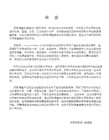
商务英语语篇的特点及其翻译要点1 商务英语语篇的类型及其语篇模式(1)问题解决型(2)直接表述型(3)间接表述型(4)解析型(5)比较——对比型(6)等级型(7)时间发展型(8)空间型(9)主张——反主张型2 商务英语语篇的文体特点2.1 首先,商务英语在进行一般叙述时多使用日常用语,但涉及商贸活动时则大量使用专业词汇和具有商务含义的准商贸术语。
例如:sole license (排他性许可证)Exclusive license (独占性许可证)Counter offer (还盘)Counter suggestion (反还盘)Irrevocable letter of credit (不可撤销信用证)Insurance policy (保险单)Clearance sale (清仓削价销售)2.2商务英语语言灵活且丰富。
不同的词序、介词以及单复数变化都会导致词义发生重大的变化,并给翻译带来一定的困难。
例如:property in goods (货权)property of goods (货物属性) Appearance surface (外表) surface appearance (表面状况)商务英语使用一词多义现象也很丰富,例如:instrument of payment (支付工具)instrument of pledge (抵押契据) instrument of ratification (批准证书) ,instrument of credit control (信用管制手段),instrument of acquisition (购置凭证)。
此外,不同搭配也可能会给理解造成困难,例如:straight B/L (记名提单),direct B/L (直达提单);clean credit (光票信用证),documentary clean credit (无跟单信用证)。
因此,我们在翻译时一定要对原文用词上的细微差别加以认真分析,确保对原文的准确解读,这样才可能产出既忠实又通顺的译文。
合同英语的词汇特点及翻译要点
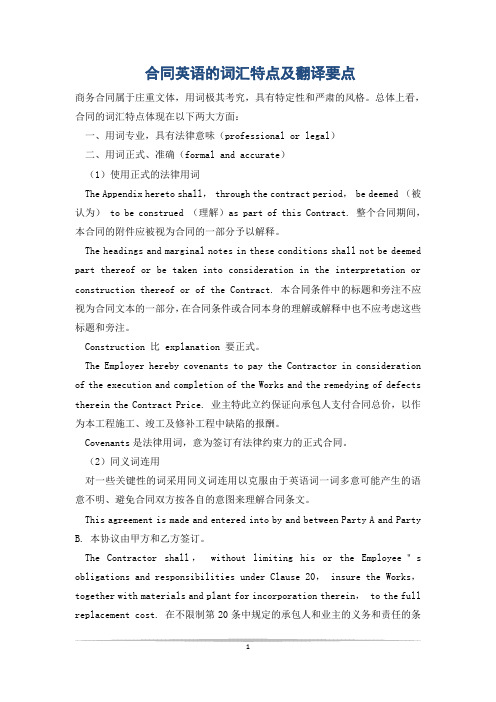
合同英语的词汇特点及翻译要点商务合同属于庄重文体,用词极其考究,具有特定性和严肃的风格。
总体上看,合同的词汇特点体现在以下两大方面:一、用词专业,具有法律意味(professional or legal)二、用词正式、准确(formal and accurate)(1)使用正式的法律用词The Appendix hereto shall, through the contract period, be deemed (被认为) to be construed (理解)as part of this Contract. 整个合同期间,本合同的附件应被视为合同的一部分予以解释。
The headings and marginal notes in these conditions shall not be deemed part thereof or be taken into consideration in the interpretation or construction thereof or of the Contract. 本合同条件中的标题和旁注不应视为合同文本的一部分,在合同条件或合同本身的理解或解释中也不应考虑这些标题和旁注。
Construction 比 explanation 要正式。
The Employer hereby covenants to pay the Contractor in consideration of the execution and completion of the Works and the remedying of defects therein the Contract Price. 业主特此立约保证向承包人支付合同总价,以作为本工程施工、竣工及修补工程中缺陷的报酬。
Covenants是法律用词,意为签订有法律约束力的正式合同。
(2)同义词连用对一些关键性的词采用同义词连用以克服由于英语词一词多意可能产生的语意不明、避免合同双方按各自的意图来理解合同条文。
合同英语单词怎么写

⼀一、引⾔言合同中经常出现⼀一些很⽣生僻的英语单词,很容易易被⼤大家误解或误译,造成不不必要的误会和损失。
有别于⽇日常英语,合同英语的⽤用词极其考究,具有专业化(professional)、正式(formal)、准确(accurate)的特性。
⼆二、起⼿手式合同英语的⽤用词特点(Formal term)1. 关于情态动词的使⽤用:May, shall, must ,may not ,shall notMay, shall , must ,may not ,shall not这些单词在合同中要格外⼩小⼼心使⽤用。
权利利和义务的任命构成合同的责任。
这些词的选择不不当可能会引起争议。
May约定当事⼈人的权利利(可以做什什么)Shall约定当事⼈人的义务(应当做什什么)Must强制性义务(必须做什什么)May not/Shall not禁⽌止性义务(不不得做什什么)•May do 不不能说成can do或shall do,不不能说成should do或ought to do•May not do 在美国⼀一些法律律⽂文件可以⽤用shall not,但绝不不能⽤用can not do或must not在约定争议解决条款时,可以说:The parties hereto shall ,first of all,settle any dispute arising from or in connection with the contract by friendly negotiations.(双⽅方⾸首先应通过友好协商,解决因合同⽽而发⽣生的或与合同有关的争议。
)Should such negotiations fail,such dispute maybe referred to the Court having jurisdiction on such dispute for settlement in the absence of any arbitration clause in the disputed contract or in default of agreement reached after such dispute occurs. (如果协商未果,合同中⼜又⽆无仲裁条款约定或争议发⽣生后未就仲裁达成协⽅方的,可将争议提交有管辖权的⼈人⺠民法院解决。
合同英语翻译(精选多篇)

合同英语翻译(精选多篇)第一篇:最常见的英语英语合同翻译最常见的英语英语合同翻译鉴于现在对外交流事例逐渐增多,英文合同特别是经济合同的翻译愈显重要,若译文不准确或不严谨,势必会引起不必要的经济纠纷.故今以一英文合同写作书籍为蓝本,录入一些有益文字,希望大家共同提高英文合同的翻译和写作。
合同文件是合同双方签订并必须遵守的法律文件,因此合同中的语言应体现其权威性.英文合同用语的特点之一就表现在用词上,即选择那些法律用词,以及正式用词,使合同表达的意思准确无误,达到双方对合同中使用的词无可争议的程度。
一.hereby英文释义:by means of , by reason of this中文译词:特此,因此,兹用法:常用于法律文件、合同、协议书等正式文件的开头语;在条款中需要强调时也可用。
语法:一般置于主语后,紧邻主语. 例1:the employer hereby covenants to pay the contractor in consideration of the execution and completion of the works and the remedying of defects therein the contract price or such other sum as may become payable under the provisions of the contract at the time and in the manner prescribed by the contract.参考译文:业主特此立约保证在合同规定的期限内,按合同规定的方式向承包人支付合同价,或合同规定的其它应支付的款项,以作为本工程施工、竣工及修补工程中缺陷的报酬。
注释:(1)hereby: by reason of this 特此(2)covenant: v. make a formal agreement 立约,签订合同、条约; n. legal agreement具有法律约束的正式合同(3)completion of the works: 工程的竣工(4)therein: in the works在本工程中(5)the contract price: 合同总价,指工程的总造价(6)such...as: 关系代词,相当于that, which(7)under: in accordance with 根据,按照(8)the provisions of the contract: terms and conditions of the contract合同条款例2:we hereby certify to the best of our knowledge that the foregoing statement is true and correct and all available information and data have been supplied herein, and that we agree to provide documentary proof upon your request.注释:(1)hereby:特此(2)to the best of our knowledge:as far as we know据我们所知(3)foregoing statement:above-mentioned statement上述声明(4)herein:in this, in the statement在声明中(5)documentary proof:证明文件参考译文:特此证明,据我们所知,上述声明内容真实,正确无误,并提供了全部现有的资料和数据,我们同意,应贵方要求出具证明文件。
合同书 翻译
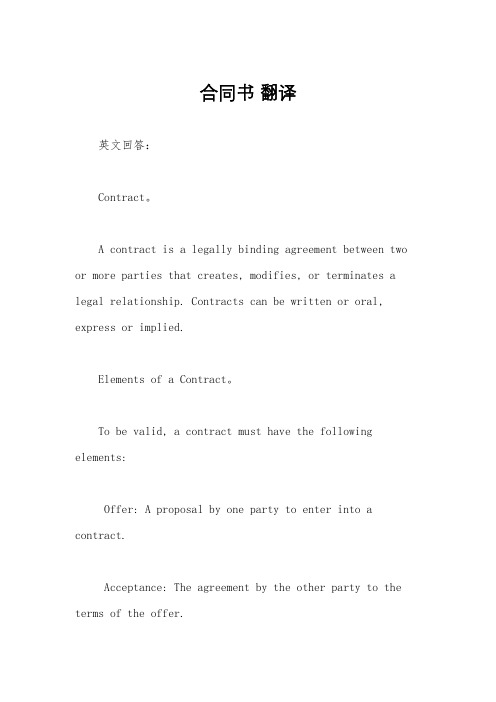
合同书翻译英文回答:Contract。
A contract is a legally binding agreement between two or more parties that creates, modifies, or terminates a legal relationship. Contracts can be written or oral, express or implied.Elements of a Contract。
To be valid, a contract must have the following elements:Offer: A proposal by one party to enter into a contract.Acceptance: The agreement by the other party to the terms of the offer.Consideration: Something of value exchanged between the parties, such as money, goods, or services.Capacity: The legal ability of the parties to enter into a contract.Legality: The purpose of the contract must not be illegal.Types of Contracts。
There are many different types of contracts, including:Bilateral contracts: Contracts where both parties make promises to each other.Unilateral contracts: Contracts where one party makes a promise to the other party in exchange for their performance.Executed contracts: Contracts where both parties havefulfilled their obligations.Executory contracts: Contracts where one or both parties have yet to fulfill their obligations.Void contracts: Contracts that are not legally binding due to a lack of one or more essential elements.Voidable contracts: Contracts that are legally binding but can be canceled by one or both parties under certain circumstances.Breach of Contract。
合同和协议的翻译
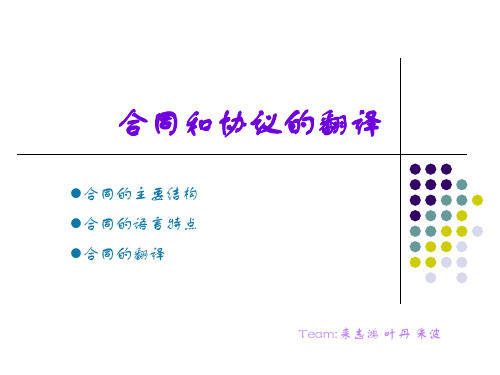
Arbitration Commission, Beijing and the arbitration rules of this Commission
shall be applied. The award of the arbitration shall be final and binding upon the Parties hereto. The Arbitration fee shall be borne by the losing party unless otherwise awarded by the Arbitration Commission.
練 習&補 充
here, there, where 等副词加上in, on, to, by, of, after等介词或介词组合构成的复合词 的使用尤为常见。
hereby hereto thereby
特此,兹 本文件 从而
thereto
whereby whereto
XX中的
凭此协议 对于那个
合同翻译注意词语
合同案例
All disputes arising from the performance of this Contract shall, through amicable negotiations, be settled by the Parties hereto. Should, through negotiations, no settlement be reached, the case in question shall then be submitted for arbitration to the China International Economic and Trade
商务英语的语言特点及其翻译

商务英语的语言特点及其翻译摘要商务英语是在商业场合中使用的一种英语,包括国际贸易、金融和通讯。
商务英语具有其独特的语言特点,包括特定的词汇、表达方式和语法结构。
本文将讨论商务英语的语言特点以及翻译商务英语文件时的挑战和策略。
介绍随着世界变得越来越全球化,商务英语已成为国际贸易、金融和通讯中必不可少的交流工具。
商务英语是在商业场合中使用的一种英语,包括书面沟通,如电子邮件、报告和合同,以及口头交流,如会议和谈判。
商务英语与普通英语相比有很多不同之处,具有独特的词汇、表达方式和语法结构。
因此,翻译商务英语文件可能会面临一些挑战,需要采取一些特殊的策略。
商务英语的语言特点商务英语与普通英语相比有很多不同之处。
商务英语的语言特点如下:专业词汇商务英语中使用了很多专业术语,如市场营销、财务、管理等领域的术语。
这些专业词汇对于了解商务英语文件的内容和含义非常重要。
表达方式商务英语文件通常使用正式的、礼貌的和间接的表达方式。
商务英语文件的作者通常需要遵守一定的礼节和规范,以使文档看起来专业和可信。
语法结构商务英语的语法结构通常更为复杂。
商务英语文件通常需要使用复杂的句子结构、从句和动词时态来表达复杂的概念。
翻译商务英语的挑战和策略翻译商务英语文件时可能会面临一些挑战,包括:专业术语的翻译商务英语文件中使用了很多专业术语,这些术语在不同的领域和文化中可能有不同的含义。
因此,在翻译商务英语文件时,需要了解这些术语的含义并选择合适的翻译方法。
翻译正式的、礼貌的和间接的表达方式商务英语文件通常使用正式的、礼貌的和间接的表达方式,这可能在不同的文化中有不同的含义。
因此,在翻译商务英语文件时,需要考虑目标读者的文化背景,并使用适当的表达方式来传达文档的含义。
复杂的语法结构商务英语文件通常使用复杂的语法结构来表达复杂的概念,这可能会使翻译变得更加困难。
因此,在翻译商务英语文件时,需要了解文档的语法结构,并使用适当的翻译方法来传达文档的含义。
常见的英语合同带翻译

常见的英语合同带翻译合同是大家平时的常见的凭证,我们在此献上英语合同范文,期望对大家有所协助。
英语推销必须具备:房屋租赁英语合同范文The parties to the contract agree as follows:合同双方均同意以下条款如下:1. The Lessor agrees to lease and the Lessee agrees to take on lease unit of shophouses, Room Nos _____, situated at _____Road, Tambon ______, District of _____, Province of _____, with telephone number _____, for a period of ____ years at a monthly rental of ___ Yuan.出租人同意出租,承租人同意租赁坐落于____府____区____乡____路的店房___间,房号为____,电话号码为____,租期为____年,月租金_____元。
2. The Lease period aforementioned in Clause 1 shall be effective as of the date the Lessor completes all details as in Clause 3, and notifies the Lessee in writing within 7 days thereof.在以上第1条款中所规定的租期,从出租人完成第3条款所有规定并在7天内通知承租方后开始生效。
3. The Lessor agrees to complete repair of the shophouse in accordance with the following details:出租人同意按以下具体规定完成该店房的维修工作。
- 1、下载文档前请自行甄别文档内容的完整性,平台不提供额外的编辑、内容补充、找答案等附加服务。
- 2、"仅部分预览"的文档,不可在线预览部分如存在完整性等问题,可反馈申请退款(可完整预览的文档不适用该条件!)。
- 3、如文档侵犯您的权益,请联系客服反馈,我们会尽快为您处理(人工客服工作时间:9:00-18:30)。
英语合同的特点与翻译一.用词特点与翻译要点合同英语的用词极其考究,具有特定性1.要求选词专业化(professional), 正式(formal). 准确(accurate). 具体体现在下列方面:1.may, shall, must, may not (或shall not) 的使用may旨在约定当事人的权利(可以做什么),shall约定当事人的义务(应当做什么时候),must 用于强制性义务(必须做什么),may not(或shall not)用于禁止性义务(不得做什么)。
May not do 在美国一些法律文件可以用shall not, 但绝不能用can not do 或must not,但may do 不能。
2.用语正式(formal)合同英语有着严肃的风格,如“因为”的短语多用“by virtue of”, 远远多于”due to”一般不用“because of”; ”财务年度末“一般用”at the close of the fiscal year”, 而不用” in the end of the fiscal year”; “在……之前”一般用“prior to”, 而不用”before”; “关于“常用”as regards”, “concerning’或”relating to”, 而不会用”about”; “事实上”用”in effect”, 而不用”in fact”: “开始“用”commencement”, 而不用”start”或”begin”; “停止做”用”cease to do”, 而不用”stop to do”; 何时开会并由某某主持“的表述为:The meeting shall be convened and presided by sb. 其中”召开“不用”hold 或call”, 而用”convene”; “主持’不用”chair”或” be in charge of “而用” preside”; “其他事项”用”miscellaneous”, 而不用” other matters/events”; “理解合同“用”construe a contract”或”comprehend a contract”或”comprehend a contract”, 而不用”understand a contract”; “认为”用“deem”, 用”consider”少,不用”think”或”believe”. 3,用词专业(technical)合同用词不以大众是否理解和接受为转移,它是合同语言准确表达的保障。
如合同出现的”瑕疵”,”救济“,“不可抗力”,“管辖”,“毁损”,“失业”等就可能让非行业人士费解,在英语以上表达分别为defect ,remedy,force马绝热,jurisdiction,damage and/or loss。
另外几乎每个合同都少不了hereinafter referred to as, whereas, in witness whereof, for and on behalf of, hereby, 用”compensation”; “不动产转让“用”conveyance”, 而不用”transfer of real estate”; “房屋出租”用”tendency”, 而“财产出租”用”lease of property”; “停止”用”wind up a business”或”cease (名词是cessation)a business”, 而不用”end/stop a business”; “依照合同相关规定“或一般说”pursuant to provisions contained herein”或”as provided herein”等,不说’according to relevant terms and conditions in the contract”。
4,同义词,近义词,相关词的并列使用英文合同出于严谨和杜绝漏洞的考虑,“made and entered into”, “by and between”, “for and in consideration of”, “covenants and agreements”, “on the terms and subject to the conditions”“terms and conditions””release and discharge”5, 古英语与外来词的应用(borrowing words)使用古英语最为突出的是较多使用here, there, where 加后缀in, by after, from等介词构成的词。
在法律文件中用这些词,可以避免重复,避免歧义,使行文准确,简洁。
常用例词如下:hereafter, hereby, herein, hereof, hereto, hereunder, hereupon, herewith, hereinbefore, hereinafter, thereafter, thereby, therein, thereinafter, thereinbefore, thereon, thereof, thereunder, thereupon, therewith, whereas, whereby, wherein, whereof, whereon, etc.合同中也会使用一些外来词汇,常用的有拉丁语和法语词汇。
如比例税率:用pro rate tax rate 要比proportional tax rate 多;从事慈善性服务的律师:pro bono lawyer, 不经常用lawyer engaged in charitable legal assistance, 委托代理人多用agent ad litem二,句法特点与翻译要点商务合同的句法具有结构严谨、句式较长的特点。
句子的状语(从句)和定语(从句)等附加成分很多,且往往位置明显,对主句意义进行解释、限制或补充。
多用陈述句、多用现在时、多用被动语态、多用名词性结构等。
1、长句及其翻译分析合同长句的基本方法是:首先,找出全句的主语、谓语和宾语。
其次,找出句子中所有的谓语结构、非谓语结构、介词短语和从句的引导词,然后在分析从句和短句的功能,即:是否是主语从句、宾语从句、表语从句或状语从句等,以及词、短语和从句之间的关系。
最后,分析句子中是否有固定搭配、插入语等其他成分。
(1)The Buyer may, within 15 days after arrival of the goods at the destination, lodge a claim against the seller for short-weight being supported by Inspection Certificate issued by a reputable public surveyor.这是一个简单长句,其主干为The Buyer may…lodge a claim…。
修饰谓语动词的状语有三个,分别表示时间(within 15 days after arrival of the goods at the destination)、方式(being supported by Inspection Certificate issued by a reputable public surveyor)和原因(for short-weight)。
诸多状语尽管在原文中位置灵活,然而在译文里,需按照汉语的行文规范适当进行调整:方式状语一般应置于动词之前;其他状语可以灵活处理,如本句中的时间状语可以提前至句首。
译:货物抵达目的港15天内,买方可以凭有信誉的公共检验员出示的检验证明向卖方提出短重索赔。
(2)If a Party breaches any of the representations or warranties given by it in Articles 18.1 or repeated in 18.2, then in addition to any other remedies available to the other Party under this contract or under Applicable Laws, it shall be indemnify and keep indemnified the other Party and the company against any losses, damages, costs, expenses, liabilities and claims that such Party or the Company may suffer as a result of such breach.本句的主干是it shall be indemnify and keep indemnified…against…the other Party and the company。
If引导的是条件从句,条件句的宾语部分跟随后置定语(given by it in Articles18.1 or repeated in 18.2)。
in addition to 引导的是增补成分,其核心词remedies也跟了后置定语(available to the other Party under this contract or under Applicable Laws)。
That 引导的则是后置定语修饰紧邻的五个名词。
基于以上分析,再结合汉语的行文习惯(条件在前,结构在后以及定语在所修饰的核心词之前)译:如果一方违反任何其根据第18.1条或18.2条所作的陈述及担保或重述,则另一方除根据本合同或相关法律寻求任何可能的救济之外,违约方应当赔偿另一方或合营公司因此种违反而招致的任何损伤、损坏、费用、开支、责任或赔偿。
(3)The Seller shall not be responsible for the delay of shipment or non delivery of the goods due to Force Majeure, which might occur during the process of manufacturing or in the cause of loading or transit.上句中信息的重心在句首,先表明卖方的免费事项,接着再规定由于什么原因引起的不能交货或延迟交货才会免责,后对不可抗力又做了限定。
